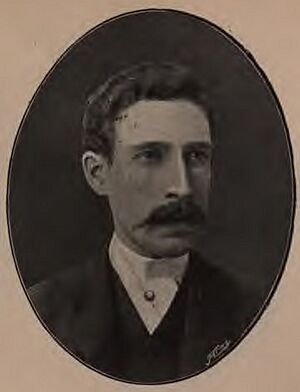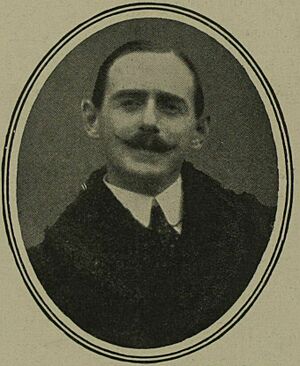Kincardineshire (UK Parliament constituency) facts for kids
Quick facts for kids {{{Name}}}[[{{{Type}}} constituency]] |
|
|---|---|
| [[Image:{{{Map1}}}Constituency.svg|120px|]] [[Image:England{{{Map2}}}.svg|120px|]] |
|
| {{{Name}}} shown within [[{{{Entity}}}]], and {{{Entity}}} shown within England | |
| Created: | {{{Year}}} |
| MP: | {{{MP}}} |
| Party: | {{{Party}}} |
| Type: | House of Commons |
| County: | [[{{{County}}}]] |
| EP constituency: | [[{{{EP}}} (European Parliament constituency)|{{{EP}}}]] |
Kincardineshire was a special area in Scotland. From 1708 to 1918, this area chose one person to represent it. This person was called a Member of Parliament (MP). They worked in the House of Commons. This is part of the Parliament of Great Britain and later the Parliament of the United Kingdom.
Contents
How Kincardineshire Became a Constituency
Before 1708, Scotland had its own Parliament. But in 1707, Scotland and England joined together. This created the Parliament of Great Britain. Because of this, new areas were made for choosing MPs. Kincardineshire became one of these new areas in 1708. It replaced an older Scottish area with the same name.
What Area Did Kincardineshire Cover?
The Kincardineshire constituency covered most of the county of Kincardineshire. A county is like a region. Before, this county sent two people to the Scottish Parliament. However, one town, Inverbervie, was not part of this constituency. Inverbervie was a "Royal burgh," which means it was a special town with royal rights. It was part of a different constituency called Aberdeen Burghs.
How MPs Were Chosen and What Happened Next
The Kincardineshire constituency always chose one MP. The MP was elected using the "first past the post" system. This means the candidate with the most votes won. This system was used until 1918.
In 1918, the Kincardineshire constituency changed. It joined with part of another area. This new, larger area was called Kincardine and Western Aberdeenshire. So, the Kincardineshire constituency stopped existing on its own.
Members of Parliament for Kincardineshire
Many different people served as the MP for Kincardineshire. An MP's job is to represent the people of their area. They speak for them in Parliament and help make laws.
- Constituency created (1708)
| Year | Member | Party | |
|---|---|---|---|
| 1708 | Sir David Ramsay, Bt | ||
| 1710 | Sir Alexander Ramsay, Bt | ||
| 1713 | James Scott | ||
| 1734 | John Falconer | ||
| 1741 | Sir James Carnegie, Bt | ||
| 1765 | Sir Alexander Ramsay-Irvine, 6th Bt | ||
| 1768 | Robert Hepburn | ||
| 1774 | Lord Adam Gordon | ||
| 1788 | Robert Barclay Allardice | ||
| 1797 | Sir John Wishart-Belches | ||
| 1806 | William Adam | ||
| 1812 | George Harley Drummond | ||
| 1820 | Sir Alexander Ramsay, Bt | ||
| 1826 | Sir Hugh Arbuthnot | Tory | |
| 1834 | Conservative | ||
| 1865 | James Dyce Nicol | Liberal | |
| 1872 | Sir George Balfour | Liberal | |
| 1892 | John William Crombie | Liberal | |
| 1908 | Arthur Murray | Liberal | |
- Constituency abolished (1918)
Elections for Kincardineshire
Elections were held regularly to choose the MP for Kincardineshire. Sometimes, a candidate would win without anyone else running against them. This is called being "unopposed." Other times, there would be a close race between different political parties.
| Decades: |
Key Elections in the 1860s
In 1865, James Dyce Nicol won the election. He was from the Liberal Party. This was a change from the previous Conservative MPs.
Key Elections in the 1870s
After James Dyce Nicol passed away, a special election was held in 1872. George Balfour won this election. He was also a Liberal. He continued to represent Kincardineshire in the 1874 general election.
Key Elections in the 1890s
In 1892, John William Crombie became the MP. He was a Liberal Party candidate. He won against a candidate from the Kincardineshire Church Defence group. Crombie was re-elected in 1895.
Key Elections in the 1900s
John William Crombie continued to be the MP for Kincardineshire. He won again in the 1900 and 1906 elections. After he passed away, another special election was held in 1908.
Arthur Murray won this by-election. He was also from the Liberal Party.
Key Elections in the 1910s
Arthur Murray continued to be the MP for Kincardineshire. He won the election in January 1910. He also won the election in December 1910 without anyone running against him.
Another general election was planned for 1915. The Liberal Party had chosen Arthur Murray again. The Unionist Party had chosen Sidney Herbert. However, this election did not happen. This was because of the start of World War I.
See also
- Former United Kingdom Parliament constituencies



